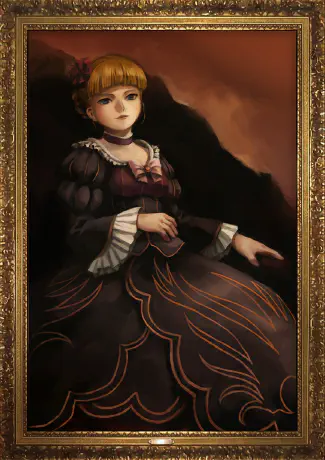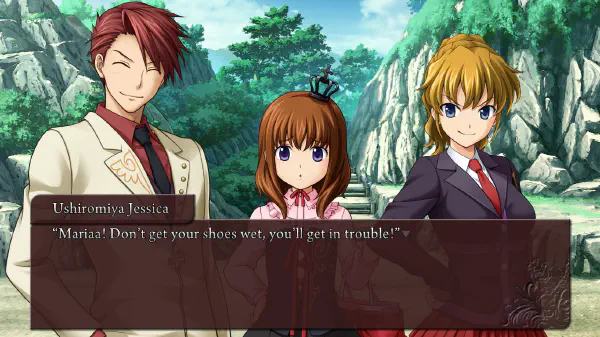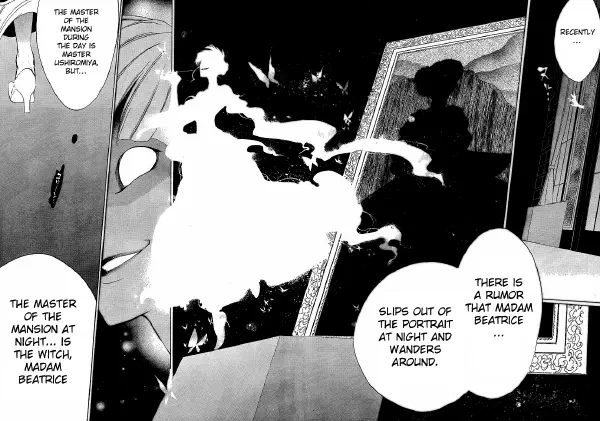Umineko and the Mystery Genre (spoiler-free)
During the last 4 months I’ve used a total of 160 hours of my free time to “play” (read would be more fitting) Umineko no Naku Koro ni, a Japanese visual novel split into 8 parts originally released between 2007 and 2010. Translated as “Umineko When They Cry”, the story is about how, during the 2 days of the yearly Ushiromiya family conference, the people present are killed in apparently impossible murders, with the bodies of the victims found in rooms locked from the inside.
The meeting takes place in Rokkenjima, the family’s private island and where their mansion is located. Could the culprit be one of the 18 present at the meeting? Could there be a 19th hidden person on the island? Or yet, maybe the culprit is the witch that, according to legend, rules the mansion by night and could’ve committed the crimes using magic…
This was my second time reading a mystery, the first having been Danganronpa (another Japanese visual novel…) 4 years ago. I remember having lots of fun at the time because I was playing it together with a friend. Every time the “culprit revealing event” was about to happen, we would pause and meet to discuss our ideas. The crimes were a bit cartoonish and convoluted, so for the most part our theories never got close to the truth… Except for the second murder. I had some ideas just like my friend, and we talked for some time, almost screaming when we would make a new connection between the leads. After weaving a solid theory, we got almost every detail right: this was no doubt one of the most fun we’ve had playing Danganronpa, just as good as the ending climax of the game. At the time, I didn’t have a habit of reading, so I didn’t even look for something that could give me this same sensation again; fortunately though, my situation with Umineko is different.
The story is heavily influenced by traditional mystery writers, both Japanese and European/American. The “one-by-one they get killed on an isolated island” is a structure borrowed from Agatha Christie’s And Then There Were None, and the book is even briefly mentioned by a character. Umineko is a mystery that is proud of its origins, making this very clear by mentioning famous authors and their writing styles. A strong trait in the genre’s japanese literature is the idea of “fair play”, that the reader should have all the needed clues to solve the mystery before the protagonist announces the answer. I had only a faint idea of the solution when it was revealed, but to understand if someone more familiar with this kind of work could solve the mystery, I read the notes of Ho-Ling Wong, who specializes in Japanese mysteries and has even translated classics to English (such as The Decagon House Murders).
The distance between our thought processes is abysmal. From episode 1 Ho-Ling has already perceived tons of details that I just couldn’t see. Not only that, but their ideas were much more creative than mine, while at the same time being more grounded. By episode 6, Ho-Ling has already solved 100% of the mysteries, while I was still untying knots caused by much simpler events.
But this should not scare anyone away from this game: just like me — a newcomer to mysteries —, Ushiromiya Battler isn’t ready to see the truth behind the October 4th and 5th tragedy. The evolution of the protagonist into someone capable of understanding how these crimes were committed is the process that moves the story forward, while also providing a “guiding hand” for players that are not getting closer to the solution on their own. Learning the many locked room tricks alongside Battler is much more pleasant than reading an entire book having no idea of what could be going on, just to listen from a super-human detective in the end that the only clue needed to solve this was the loose string on the culprit’s overcoat (but that’s a different experience and has its own value!).
As pointed out by Willard Wright in his 1926 essay, “The Detective Novel”, there is a great difference between waiting placidly for the solution of a problem, and the exhilarating participation in its deduction. In any other literary genre, the reader simply waits for the author to unravel a web of events; in a mystery novel, however, a maze is built and offered to the public to be solved. Wright also states that detailed characters have no place in this genre, serving only as a distraction from the main puzzle. This might be valid for books that vary between some 300 pages, but not for Umineko. A work this big would not hold anyone’s interest until it’s end if it hadn’t interesting characters. That is why I think Umineko to be a great introduction to mysteries: having double the word count of The Lord of the Rings combined with The Hobbit, failing to solve a mystery bares little to no weight, for it is just a drop in an ocean of events. While waiting for the next mystery, it’s possible to reflect and learn with the last one, while still enjoying a good story.
And be it on the more calm moments or during the faster-paced ones, my verdict is that playing Umineko without a good pair of headphones is a crime against the work. The author, Ryukishi07, classifies it as a “sound novel”, and only fools would disagree with him here. Not only is the voice acting spectacular, but the soundtrack is just unbelievable. When I was making a playlist of my favorite tracks, I was adding almost all of them in. Even after performing a more rigorous selection, the final playlist still ended up with 70 items! And if we look at just these 70 tracks, there still is a great range of emotions: from the melancholy of Voiceless to the power of Fake Red Shoes, passing through the sinister elegance of Scorpion Entrails and the smugness of Golden Sneer (and all of these are from the very first parts of the game!).
But as good as the soundtrack is, it can’t by itself fix the greatest problem in the game: the absurdly slow start. I have no doubts that the majority of people that quit reading Umineko did it before hitting the 10-hour mark. In these first hours (which represent half of the first episode!) the characters and the inner workings of the Ushiromiya family are introduced. It’s a combination of discussing family inheritance, investments, tea, bad blood, leadership succession… Carefully picked ingredients to create the most boring start a visual novel could ever have. Another negative aspect is the length it has, which varies around 150 hours of reading. If your job was to read Umineko, 8 hours a day, 5 days a week, you’d take a month to finish it. Even though this is the thing I think makes Umineko a good introduction to mysteries as I’ve mentioned before (a failed mystery gets diluted by the rest of the content), it is also the thing that will scare the most people away from it (mainly the newcomers: —“Got some introductory reading?” —“Sure! And it’s just as small as the combined Harry Potter saga!”). At least the second half of the 1st episode gets more exciting. The 2nd episode presents the main “mechanic” used throughout the story, and after the 3rd, I don’t think it’s possible for someone to stop reading (and it’s “just” 60 hours to that point!).
The first 4 episodes make the first half of the game, presenting the mystery, developing the characters and training Battler to solve locked rooms. Starting from the 5th episode, the reader that until now was free to come up with any absurd theory to explain the crimes, receives information to think in more plausible ways of committing the murders. When I finished this episode, I pondered for some time if I should go back and re-read the previous episodes, better trained in solving locked rooms and having new info. I ended up not doing it, because like any normal person, I don’t have the patience to spend 80 more hours in front of the computer to re-read content. It’s because of this that many recommend reading the manga adaptation at this point of the story, for it is shorter. Some minor but time-consuming details are lost, of course (like some tea talk), but I’m sure those who have read the visual novel will see this as a blessing (the first 10 hours happen in just 7 chapters!). If I knew of this adaptation when I was playing, I would’ve probably read it in order to try and solve the mystery (but even so I don’t think I would’ve solved it), because with 100 hours of Umineko under my belt I felt much more prepared than when I started playing it in December of last year. This “training” improved me a good much, to the point that, when a “mini locked-room mystery” was presented to me, the solution popped into my head almost immediately. On the next paragraph is an adaptation of this mystery, so you can try and solve it. When you think of a theory that solves the case, click on a point to reveal a fact; if it breaks your theory, reformulate it and repeat this process. Good luck! (Try listening to this arrangement of Dead Angle while thinking!)
In a mansion where each servant carries a keyring with keys to all the rooms, James wants to play a trick on his workmate, Alice. When the two are allocated to clear a room together the next day, James starts to scheme…
The shift begins: entering the room, Alice unlocks the door, throws her keyring on the bed, turns around and starts cleaning. James enters the room and too starts cleaning.
When the cleaning is done, Alice takes the keyring on the bed and the both of them leave the room. When she tries locking the room, Alice notices the key for this door is missing from the keyring. The two of them, together, start looking for it and find it in the living room. How could’ve James put the key here if Alice herself unlocked the room at the start of the shift?
Answer:
If I was tasked with solving this before I played Umineko, no doubt I wouldn’t have thought of an answer. At most, something absurd like “James used a secret passage and a remotely controlled device…” yada yada. A solution that would not violate any of the presented facts, but a very ugly one. This point is also debated in Umineko: the mutual trust between the writer and the reader of mystery novels. The reader needs to trust the solution is grounded and makes sense, while the writer needs to trust the public will try and solve their mystery even if it looks impossible. When one of these premises is broken (the final answer is not good enough or the reader insists the crime is impossible and stops thinking) a mystery novel loses all it’s potential. This kind of “meta-discussion” (a mystery talking about mysteries) gives me even more confidence in recommending Umineko to newcomers.
If you’ve become interested in the game, aware of it’s size and slow start, it has my strongest recommendation. Even if I was not capable of solving the greater mystery before the answer was shown, and thinking the solution to be kinda hard to deduce (and maybe even cruel to the reader!), the journey that took me there was well worth it and provided plenty of memorable moments. Just don’t try replacing the visual novel with the manga: I really consider it as more of a supplement to the game, serving as a quick refresher of past events and providing a more detailed explanation of the mystery in the final volumes. It is good, but in order to cause an impression, it needs you to have created bonds with the story through playing the visual novel.
And one last thing: if you’re going to play it, don’t stress over the answer for the epitaph. I’m 100% sure it can’t be solved before its answer is shown.

